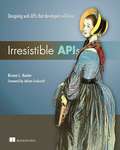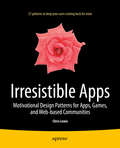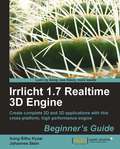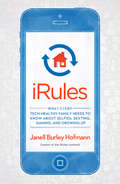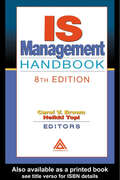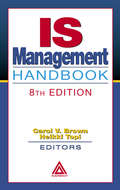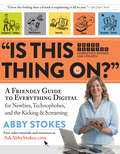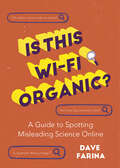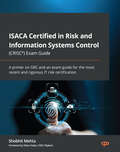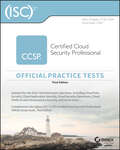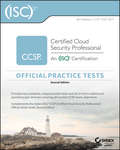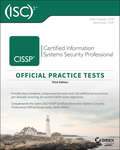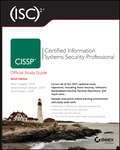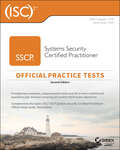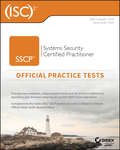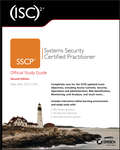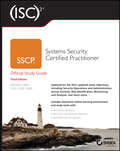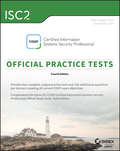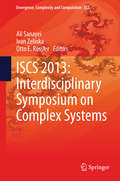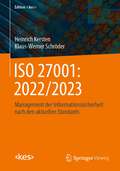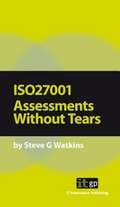- Table View
- List View
Irresistible APIs: Designing web APIs that developers will love
by Kirsten HunterSummaryA Web API is a platform with a web-style interface developers can use to implement functionality. Well-designed APIs feel like a natural extension of the application, rather than just a new interface into the backend database. Designing Web APIs based on use cases allows an organization to develop irresistible APIs, which developers can consume easily and which support the business values of that organization.Purchase of the print book includes a free eBook in PDF, Kindle, and ePub formats from Manning Publications.About the TechnologyIt takes a village to deliver an irresistible web API. Business stakeholders look for an API that works side-by-side with the main product to enhance the experience for customers. Project managers require easy integration with other products or ways for customers to interact with your system. And, developers need APIs to consistently interoperate with external systems. The trick is getting the whole village together. This book shows you how.About the BookIrresistible APIspresents a process to create APIs that succeed for all members of the team. In it, you'll learn how to capture an application's core business value and extend it with an API that will delight the developers who use it. Thinking about APIs from the business point of view, while also considering the end-user experience, encourages you to explore both sides of the design process and learn some successful biz-to-dev communication patterns. Along the way, you'll start to view your APIs as part of your product's core value instead of just an add-on.What's InsideDesign-driven developmentDeveloping meaningful use casesAPI guiding principlesHow to recognize successful APIsAbout the ReaderWritten for all members of an API design team, regardless of technical level.About the AuthorKirsten Hunter is an API evangelist who helps developers and business stakeholders understand, design, and deliver amazing APIs.Table of ContentsUNDERSTANDING WEB APIsWhat makes an API irresistible?Working with web APIsAPI FirstWeb services explainedDESIGNING WEB APIsGuiding principles for API designDefining the value for your APICreating your schema modelDesign-driven developmentEmpowering your developers
Irresistible Apps
by Chris LewisThis practical guide provides a comprehensive overview of professionally managed assets, or investments in which all portfolio decisions and rebalancing are delegated to a fund manager or third-party advice service. Savvy investors looking to achieve a better understanding of the nuances, benefits, and drawbacks of using these products?will find the answers they are looking for in?The Handbook of Professionally Managed Assets, ?no matter whether they would like to learn more about mutual funds or hedge funds. There is a considerable lack of knowledge among the investing public about how to properly construct a well-diversified portfolio of investments that includes a selection of professionally managed assets. As a long-standing financial planner, attorney, and educator, Keith Fevurly remedies this issue in The Handbook of Professionally Managed Assets?by clearly presenting the major categories of professionally managed assets and revealing the best tactics for investing in these vehicles. Along the way, he reveals each asset''s risks and rewards, and he also provides the in-depth knowledge and information investors need to confidently select the right assets for their portfolios. Filled with valuable insights for everyone from financial professionals to individual investors, The Handbook of Professionally Managed Assets?stands alone in its ability to shed light on the many investment vehicles that fall under the larger umbrella of professionally managed assets. With topics as wide-ranging as mutual funds, closed-end funds, unit investment trusts, exchange traded funds, hedge funds, managed futures, and more, this invaluable resource will give you the information you need to build a prosperous financial future for yourself and your clients.
Irrlicht 1.7 Realtime 3D Engine Beginner's Guide
by Johannes Stein Aung Sithu KyawA beginner's guide with plenty of screenshots and explained code. If you have C++ skills and are interested in learning Irrlicht, this book is for you. Absolutely no knowledge of Irrlicht is necessary for you to follow this book!
iRules: What Every Tech-Healthy Family Needs to Know about Selfies, Sexting, Gaming, and Growing up
by Janell Burley HofmannAs Janell Burley Hofmann, mother of five, wrapped her 13-year-old's iPhone on Christmas Eve, she was overwhelmed by questions: "Will my children learn to sit and wonder without Googling? Should I know their passwords for online accounts? Will they experience the value of personal connection without technology?"To address her concerns, she outlined boundaries and expectations in a contract for her son to sign upon receiving his first cell phone. When Hofmann's editor at The Huffington Post posted the contract, now known as iRules, it resonated on a massive scale and went viral, resulting in a tsunami of media coverage and requests. It quickly became apparent that people across the country were hungry for more.In iRules, Hofmann provides families with the tools they need to find a balance between technology and human interaction through a philosophy she calls Slow Tech Parenting. In the book, she educates parents about the online culture tweens and teens enter the minute they go online, exploring issues like cyberbullying, friend fail, and sexting, as well as helping parents create their own iRules contracts to fit their families' needs. As funny and readable as it is prescriptive, iRules will help parents figure out when to unplug and how to stay in sync with the changing world of technology, while teaching their children self-respect, integrity, and responsibility.
Is AI Good for the Planet? (Digital Futures)
by Benedetta BreviniArtificial intelligence (AI) is presented as a solution to the greatest challenges of our time, from global pandemics and chronic diseases to cybersecurity threats and the climate crisis. But AI also contributes to the climate crisis by running on technology that depletes scarce resources and by relying on data centres that demand excessive energy use. Is AI Good for the Planet? brings the climate crisis to the centre of debates around AI, exposing its environmental costs and forcing us to reconsider our understanding of the technology. It reveals why we should no longer ignore the environmental problems generated by AI. Embracing a green agenda for AI that puts the climate crisis at centre stage is our urgent priority. Engaging and passionately written, this book is essential reading for scholars and students of AI, environmental studies, politics, and media studies and for anyone interested in the connections between technology and the environment.
IS Management Handbook
by Carol V. Brown Heikki TopiIn systems analysis, programming, development, or operations, improving productivity and service - doing more with less - is the major challenge. Regardless of your management level, the Handbook gives you the advice and support you need to survive and prosper in the competitive environment. It is the only comprehensive and timely source of technic
IS Management Handbook
by null Carol V. Brown null Heikki TopiIT management and staff are called upon to perform the almost-impossible tasks of evaluating, purchasing, integrating, and maintaining complex IT systems, and directing these systems to meet the ever-changing goals of an organization. Add to that the spending restraints of a down economy, and IT managers find themselves in need of a thoughtful, rea
"Is This Thing On?": A Friendly Guide to Everything Digital for Newbies, Technophobes, and the Kicking & Screaming
by Abby StokesLike a personal trainer for the digital age, Abby Stokes is the hand-holding, motivating expert that newbies—specifically older newbies—turn to when they want to become digitally literate. And her book, Is This Thing On?, is as smart, comprehensive, reassuring, and jargon-free as she is: the epitome of user-friendly. <P><P>And it is now completely revised and updated to keep pace with the fast-changing digital landscape, covering tablets, apps, video streaming, social media, and much more. <P>With the skill and assurance of a teacher who for over 20 years has personally taught computer skills to thousands of seniors and technophobes, Stokes covers it all: How to choose, buy, and start using the computer or tablet that’s just right for you, plus how to set everything up for maximum comfort and safety. How to connect to the Internet, sign up for email, understand and use search engines, and get started with essential skills like word processing and text messaging. How to choose, buy, and start using a smartphone. How to take and share digital photographs and videos. How to discover online communities and participate in social media like Facebook, Instagram, Pinterest, Twitter, YouTube, and blogs. How to explore the world of apps, online music, streaming movies, and ebooks. And, importantly, online security— including what to do when things go wrong. Appendices include both Apple and PC keyboard shortcuts and 200 recommended websites and 100 apps; there are FAQs at the end of each chapter and tips and tricks throughout. <P> An all-new companion website—AskAbbyStokes.com—will include video tutorials explaining the latest technologies.
Is This Wi-Fi Organic?: A Guide to Spotting Misleading Science Online
by Dave FarinaHow to separate facts from fake science in the Disinformation Age: “Cuts through the chaos . . . sure to keep you laughing while also keeping you thinking.” —Matt Candeias, PhD, author of In Defense of PlantsWe live in an era when scams, frauds, fake news, fake stories, fake science, and false narratives are everywhere. Fortunately, you don’t need a BS in Science to spot science BS. This guide from educator Dave Farina, aka YouTube’s Professor Dave, is a playful yet practical investigation of popular opinions and consumer trends that permeate our society. Shoppers insist on “organic” everything even if they’re unable to define the term. Healers and quantum mystics secure a foothold alongside science-based medicine in an unregulated and largely unchallenged landscape. Misleading marketing is used to sell you products and services that range from ineffectual to downright dangerous.With the knowledge gained from Dave Farina’s simple explanations of basic scientific principles, you can learn to spot misinformation and lies on the internet before they spot you. Learn the real science behind such semi-controversial subjects as drugs, vaccines, energy, and biotechnology—and most importantly, arm yourself with the critical-thinking skills everyone needs in a world filled with nonsense.“Scientific literacy is our best defense in an age of increasing disinformation.” —Kellie Gerardi, aerospace professional and author of Not Necessarily Rocket Science
ISACA Certified in Risk and Information Systems Control (CRISC®) Exam Guide: A primer on GRC and an exam guide for the most recent and rigorous IT risk certification
by null Shobhit MehtaPrepare to pass the ISACA CRISC exam with confidence, gain high-value skills, and propel yourself toward IT risk management masteryKey FeaturesGain end-to-end coverage of all the topics assessed in the ISACA CRISC examApply and embed your learning with the help of practice quizzes and self-assessment questionsHave an in-depth guide handy as you progress in your enterprise IT risk management careerPurchase of the print or Kindle book includes a free PDF eBookBook DescriptionFor beginners and experienced IT risk professionals alike, acing the ISACA CRISC exam is no mean feat, and the application of this advanced skillset in your daily work poses a challenge. The ISACA Certified in Risk and Information Systems Control (CRISC®) Certification Guide is a comprehensive guide to CRISC certification and beyond that’ll help you to approach these daunting challenges with its step-by-step coverage of all aspects of the exam content and develop a highly sought-after skillset in the process. This book is divided into six sections, with each section equipped with everything you need to get to grips with the domains covered in the exam. There’ll be no surprises on exam day – from GRC to ethical risk management, third-party security concerns to the ins and outs of control design, and IDS/IPS to the SDLC, no stone is left unturned in this book’s systematic design covering all the topics so that you can sit for the exam with confidence. What’s more, there are chapter-end self-assessment questions for you to test all that you’ve learned, as well as two book-end practice quizzes to really give you a leg up. By the end of this CRISC exam study guide, you’ll not just have what it takes to breeze through the certification process, but will also be equipped with an invaluable resource to accompany you on your career path.What you will learnAdopt the ISACA mindset and learn to apply it when attempting the CRISC examGrasp the three lines of defense model and understand risk capacityExplore the threat landscape and figure out vulnerability managementFamiliarize yourself with the concepts of BIA, RPO, RTO, and moreGet to grips with the four stages of risk responseManage third-party security risks and secure your systems with easeUse a full arsenal of InfoSec tools to protect your organizationTest your knowledge with self-assessment questions and practice quizzesWho this book is forIf you are a GRC or a risk management professional with experience in the management of IT audits or in the design, implementation, monitoring, and maintenance of IS controls, or are gearing up to take the CRISC exam, then this CRISC book is for you. Security analysts, penetration testers, SOC analysts, PMs, and other security or management professionals and executives will also benefit from this book. The book assumes prior experience of security concepts.
ISBI 2019 C-NMC Challenge: Select Proceedings (Lecture Notes in Bioengineering)
by Anubha Gupta Ritu GuptaThis book comprises select peer-reviewed proceedings of the medical challenge - C-NMC challenge: Classification of normal versus malignant cells in B-ALL white blood cancer microscopic images. The challenge was run as part of the IEEE International Symposium on Biomedical Imaging (IEEE ISBI) 2019 held at Venice, Italy in April 2019. Cell classification via image processing has recently gained interest from the point of view of building computer-assisted diagnostic tools for blood disorders such as leukaemia. In order to arrive at a conclusive decision on disease diagnosis and degree of progression, it is very important to identify malignant cells with high accuracy. Computer-assisted tools can be very helpful in automating the process of cell segmentation and identification because morphologically both cell types appear similar. This particular challenge was run on a curated data set of more than 14000 cell images of very high quality. More than 200 international teams participated in the challenge. This book covers various solutions using machine learning and deep learning approaches. The book will prove useful for academics, researchers, and professionals interested in building low-cost automated diagnostic tools for cancer diagnosis and treatment.
(ISC)2 CCSP Certified Cloud Security Professional Official Practice Tests
by Mike Chapple David SeidlThe only official CCSP practice test product endorsed by (ISC)2 With over 850 practice questions all new for the 2022-2025 exam objectives, (ISC)2 CCSP Certified Cloud Security Professional Official Practice Tests, 3rd Edition gives you the opportunity to test your level of understanding and gauge your readiness for the Certified Cloud Security Professional (CCSP) exam long before the big day. These questions cover 100% of the CCSP exam domains and include answers with full explanations to help you understand the reasoning and approach for each. Logical organization by domain allows you to practice only the areas you need to bring you up to par, without wasting precious time on topics you’ve already mastered. As the only official practice test product for the CCSP exam endorsed by (ISC)2, this essential resource is your best bet for gaining a thorough understanding of the topic. It also illustrates the relative importance of each domain, helping you plan your remaining study time so you can go into the exam fully confident in your knowledge. When you’re ready, two practice exams allow you to simulate the exam day experience and apply your own test-taking strategies with domains given in proportion to the real thing. The online learning environment and practice exams are the perfect way to prepare and make your progress easy to track. For this new Third Edition, cloud security experts Mike Chapple and David Seidl have delivered an all-new question set for the new CCSP 2022-2025 objectives. These authors are well known for their best-selling (ISC)2 CISSP Certified Information Systems Security Professional Official Practice Tests and now they’ve joined forces again to deliver the same high caliber practice questions for the CCSP exam.
(ISC)2 CCSP Certified Cloud Security Professional Official Practice Tests
by Ben MalisowThe only official CCSP practice test product endorsed by (ISC)² With over 1,000 practice questions, this book gives you the opportunity to test your level of understanding and gauge your readiness for the Certified Cloud Security Professional (CCSP) exam long before the big day. These questions cover 100% of the CCSP exam domains, and include answers with full explanations to help you understand the reasoning and approach for each. Logical organization by domain allows you to practice only the areas you need to bring you up to par, without wasting precious time on topics you’ve already mastered. As the only official practice test product for the CCSP exam endorsed by (ISC)², this essential resource is your best bet for gaining a thorough understanding of the topic. It also illustrates the relative importance of each domain, helping you plan your remaining study time so you can go into the exam fully confident in your knowledge. When you’re ready, two practice exams allow you to simulate the exam day experience and apply your own test-taking strategies with domains given in proportion to the real thing. The online learning environment and practice exams are the perfect way to prepare, and make your progress easy to track.
(ISC)2 CISSP Certified Information Systems Security Professional Official Practice Tests
by Mike Chapple David SeidlFull-length practice tests covering all CISSP domains for the ultimate exam prep The (ISC)2 CISSP Official Practice Tests is a major resource for (ISC)2 Certified Information Systems Security Professional (CISSP) candidates, providing 1300 unique practice questions. The first part of the book provides 100 questions per domain. You also have access to four unique 125-question practice exams to help you master the material. As the only official practice tests endorsed by (ISC)2, this book gives you the advantage of full and complete preparation. These practice tests align with the 2021 version of the exam to ensure up-to-date preparation, and are designed to cover what you will see on exam day. Coverage includes: Security and Risk Management, Asset Security, Security Architecture and Engineering, Communication and Network Security, Identity and Access Management (IAM), Security Assessment and Testing, Security Operations, and Software Development Security. The CISSP credential signifies a body of knowledge and a set of guaranteed skills that put you in demand in the marketplace. This book is your ticket to achieving this prestigious certification, by helping you test what you know against what you need to know. Test your knowledge of the 2021 exam domains Identify areas in need of further study Gauge your progress throughout your exam preparation Practice test taking with Sybex’s online test environment containing the questions from the book, which is supported by Wiley's support agents who are available 24x7 via email or live chat to assist with access and login questions The CISSP exam is refreshed every few years to ensure that candidates are up-to-date on the latest security topics and trends. Currently-aligned preparation resources are critical, and periodic practice tests are one of the best ways to truly measure your level of understanding.
(ISC)2 CISSP Certified Information Systems Security Professional Official Study Guide
by Darril Gibson Mike Chapple James Michael StewartCISSP Study Guide - fully updated for the 2021 CISSP Body of Knowledge (ISC)2 Certified Information Systems Security Professional (CISSP) Official Study Guide, 9th Edition has been completely updated based on the latest 2021 CISSP Exam Outline. This bestselling Sybex Study Guide covers 100% of the exam objectives. You'll prepare for the exam smarter and faster with Sybex thanks to expert content, knowledge from our real-world experience, advice on mastering this adaptive exam, access to the Sybex online interactive learning environment, and much more. Reinforce what you've learned with key topic exam essentials and chapter review questions. The three co-authors of this book bring decades of experience as cybersecurity practitioners and educators, integrating real-world expertise with the practical knowledge you'll need to successfully pass the CISSP exam. Combined, they've taught cybersecurity concepts to millions of students through their books, video courses, and live training programs. Along with the book, you also get access to Sybex's superior online interactive learning environment that includes: Over 900 new and improved practice test questions with complete answer explanations. This includes all of the questions from the book plus four additional online-only practice exams, each with 125 unique questions. You can use the online-only practice exams as full exam simulations. Our questions will help you identify where you need to study more. Get more than 90 percent of the answers correct, and you're ready to take the certification exam. More than 700 Electronic Flashcards to reinforce your learning and give you last-minute test prep before the exam A searchable glossary in PDF to give you instant access to the key terms you need to know for the exam New for the 9th edition: Audio Review. Author Mike Chapple reads the Exam Essentials for each chapter providing you with 2 hours and 50 minutes of new audio review for yet another way to reinforce your knowledge as you prepare. Coverage of all of the exam topics in the book means you'll be ready for: Security and Risk Management Asset Security Security Architecture and Engineering Communication and Network Security Identity and Access Management (IAM) Security Assessment and Testing Security Operations Software Development Security
(ISC)2 SSCP Systems Security Certified Practitioner Official Practice Tests
by Mike Chapple David SeidlSmarter, faster prep for the SSCP exam The (ISC)² SSCP Official Practice Tests, 2nd Edition is the only (ISC)²-endorsed set of practice questions for the Systems Security Certified Practitioner (SSCP). This book's first seven chapters cover each of the seven domains on the SSCP exam with sixty or more questions per domain, so you can focus your study efforts exactly where you need more review. When you feel well prepared, use the two complete practice exams from Sybex's online interactive learning environment as time trials to assess your readiness to take the exam.: Coverage of all exam objectives, including: Security Operations and Administration Access Controls Risk Identification, Monitoring and Analysis Incident Response and Recovery Cryptography Network and Communications Security Systems and Application Security SSCP certification demonstrates you have the advanced technical skills and knowledge to implement, monitor and administer IT infrastructure using security best practices, policies and procedures. It's ideal for students pursuing cybersecurity degrees as well as those in the field looking to take their careers to the next level.
(ISC)2 SSCP Systems Security Certified Practitioner Official Practice Tests
by David Seidl Mike ChappleSmarter, faster prep for the SSCP exam (ISC)2 SSCP Systems Security Certified Practitioner Official Practice Tests is the only (ISC)2-endorsed set of questions for the SSCP exam. With SSCP certification, you will meet Department of Defense requirements for entry-level Information Assurance Technical (IAT I) roles, positioning you for a successful career in cyber-security. This book's first seven chapters cover each of the seven domains on the SSCP exam with sixty or more questions per domain, so you can focus your study efforts exactly where you need more review. When you feel well prepared, use the two complete practice exams from Sybex's online interactive learning environment as time trials to assess your readiness to take the exam. Coverage of all exam objectives, including: Access Controls Security Operations and Administration Risk Identification, Monitoring, and Analysis Incident Response and Recovery The SSCP program certifies your ability to implement, monitor, and administer IT secure and compliant IT infrastructure. It's ideal for students pursuing cyber-security degrees as well as those in the field looking to take their careers to the next level.
(ISC)2 SSCP Systems Security Certified Practitioner Official Study Guide
by Mike WillsThe only SSCP study guide officially approved by (ISC)2 The (ISC)2 Systems Security Certified Practitioner (SSCP) certification is a well-known vendor-neutral global IT security certification. The SSCP is designed to show that holders have the technical skills to implement, monitor, and administer IT infrastructure using information security policies and procedures. This comprehensive Official Study Guide—the only study guide officially approved by (ISC)2—covers all objectives of the seven SSCP domains. Access Controls Security Operations and Administration Risk Identification, Monitoring, and Analysis Incident Response and Recovery Cryptography Network and Communications Security Systems and Application Security If you’re an information security professional or student of cybersecurity looking to tackle one or more of the seven domains of the SSCP, this guide gets you prepared to pass the exam and enter the information security workforce with confidence.
(ISC)2 SSCP Systems Security Certified Practitioner Official Study Guide
by Mike WillsThe only SSCP study guide officially approved by (ISC)2 The (ISC)2 Systems Security Certified Practitioner (SSCP) certification is a well-known vendor-neutral global IT security certification. The SSCP is designed to show that holders have the technical skills to implement, monitor, and administer IT infrastructure using information security policies and procedures. This comprehensive Official Study Guide—the only study guide officially approved by (ISC)2—covers all objectives of the seven SSCP domains. Security Operations and Administration Access Controls Risk Identification, Monitoring, and Analysis Incident Response and Recovery Cryptography Network and Communications Security Systems and Application Security This updated Third Edition covers the SSCP exam objectives effective as of November 2021. Much of the new and more advanced knowledge expected of an SSCP is now covered in a new chapter "Cross-Domain Challenges." If you're an information security professional or student of cybersecurity looking to tackle one or more of the seven domains of the SSCP, this guide gets you prepared to pass the exam and enter the information security workforce with confidence.
ISC2 CISSP Certified Information Systems Security Professional Official Practice Tests (Sybex Study Guide Ser.)
by Mike Chapple David SeidlFull-length practice tests covering all CISSP domains for the ultimate CISSP prep The ISC2 CISSP Official Practice Tests is a major resource for ISC2 Certified Information Systems Security Professional (CISSP) candidates, providing 1300 unique practice questions. The first part of the book provides 100 questions per domain. You also have access to four unique 125-question practice exams to help you master the material. As the only official practice tests endorsed by ISC2, this book gives you the advantage of full and complete preparation. These practice tests align with the 2024 version of the CISSP Detailed Content Outline to ensure up-to-date preparation, and are designed to cover what you will see on exam day. Coverage includes: Security and Risk Management, Asset Security, Security Architecture and Engineering, Communication and Network Security, Identity and Access Management (IAM), Security Assessment and Testing, Security Operations, and Software Development Security. The CISSP credential signifies a body of knowledge and a set of guaranteed skills that put you in demand in the marketplace. This book is your ticket to achieving this prestigious certification, by helping you test what you know against what you need to know. Test your knowledge of the 2024 CISSP domains Identify areas in need of further study Gauge your progress throughout your study and preparation Practice test taking with Sybex’s online test environment containing the questions from the book The CISSP objectives are refreshed every few years to ensure that candidates are up-to-date on the latest security topics and trends. Currently-aligned preparation resources are critical, and periodic practice tests are one of the best ways to truly measure your level of understanding.
ISC2 CISSP Certified Information Systems Security Professional Official Study Guide (Sybex Study Guide)
by Mike Chapple James Michael Stewart Darril GibsonCISSP Study Guide - fully updated for the 2024 CISSP Body of Knowledge ISC2 Certified Information Systems Security Professional (CISSP) Official Study Guide, 10th Edition has been completely updated based on the latest 2024 CISSP Detailed Content Outline. This bestselling Sybex Study Guide covers 100% of the CISSP objectives. You'll prepare smarter and faster with Sybex thanks to expert content, knowledge from our real-world experience, access to the Sybex online interactive learning environment, and much more. Reinforce what you've learned with key topic Study Essentials and chapter review questions. The book’s co-authors bring decades of experience as cybersecurity practitioners and educators, integrating real-world expertise with the practical knowledge you'll need to successfully prove your CISSP mastery. Combined, they've taught cybersecurity concepts to millions of students through their books, video courses, and live training programs. Along with the book, you also get access to Sybex's superior online interactive learning environment that includes: Over 900 practice test questions with complete answer explanations. This includes all of the questions from the book plus four additional online-only practice exams, each with 125 unique questions. You can use the online-only practice exams as full exam simulations. Our questions will help you identify where you need to study more. More than 1000 Electronic Flashcards to reinforce your learning and give you last-minute test prep A searchable glossary in PDF to give you instant access to the key terms you need to know Audio Review. Author Mike Chapple reads the Study Essentials for each chapter providing you with more than 2 hours of up-to-date audio review for yet another way to reinforce your knowledge as you prepare. Coverage of all of the CISSP topics in the book means you'll be ready for: Security and Risk Management Asset Security Security Architecture and Engineering Communication and Network Security Identity and Access Management (IAM) Security Assessment and Testing Security Operations Software Development Security
ISCS 2013: Interdisciplinary Symposium on Complex Systems
by Ali Sanayei Ivan Zelinka Otto E. RösslerThe book you hold in your hands is the outcome of the "ISCS 2013: Interdisciplinary Symposium on Complex Systems" held at the historical capital of Bohemia as a continuation of our series of symposia in the science of complex systems. Prague, one of the most beautiful European cities, has its own beautiful genius loci. Here, a great number of important discoveries were made and many important scientists spent fruitful and creative years to leave unforgettable traces. The perhaps most significant period was the time of Rudolf II who was a great supporter of the art and the science and attracted a great number of prominent minds to Prague. This trend would continue. Tycho Brahe, Niels Henrik Abel, Johannes Kepler, Bernard Bolzano, August Cauchy Christian Doppler, Ernst Mach, Albert Einstein and many others followed developing fundamental mathematical and physical theories or expanding them. Thus in the beginning of the 17th century, Kepler formulated here the first two of his three laws of planetary motion on the basis of Tycho Brahe's observations. In the 19th century, nowhere differentiable continuous functions (of a fractal character) were constructed here by Bolzano along with a treatise on infinite sets, titled "Paradoxes of Infinity" (1851). Weierstrass would later publish a similar function in 1872. In 1842, Doppler as a professor of mathematics at the Technical University of Prague here first lectured about a physical effect to bear his name later. And the epoch-making physicist Albert Einstein - while being a chaired professor of theoretical physics at the German University of Prague - arrived at the decisive steps of his later finished theory of general relativity during the years 1911-1912. In Prague, also many famous philosophers and writers accomplished their works; for instance, playwright arel ape coined the word "robot" in Prague ("robot" comes from the Czech word "robota" which means "forced labor").
ISIS' Propaganda Machine: Global Mediated Terrorism
by Ahmed Al-RawiThis book examines ISIS’ media propaganda machine.The book focuses on case studies that have been largely understudied in relation to ISIS’ media production. Empirically, it offers new insights into how ISIS uses its media production to disseminate its extremist ideology by focusing on video games, educational apps, Dark Web sites, and offline billboards. The book argues that despite all the discussion about how ISIS has disappeared or even died, the terrorist group’s daily activities on the Dark Web show that they are still thriving and disseminating their propaganda in more than 20 different languages, and effectively functioning as an international news organization. Using a mixed-method research approach, the book offers a multilayered understanding of media content and fills a major gap in the literature, especially in relation to the use of educational apps and the Dark Web.This book will be of much interest to students of media and communication studies, terrorism and counterterrorism, Middle Eastern politics, and international relations.
ISO 27001: Management der Informationssicherheit nach den aktuellen Standards (Edition <kes>)
by Heinrich Kersten Klaus-Werner SchröderEin qualifiziertes Management der Informationssicherheit ist heutzutage für jede Organisation unverzichtbar. Die Normenreihe ISO 27000 ist dabei ein anerkannter „Wegweiser“ zu diesem Ziel. Im internationalen Kontext ist ihre Erfüllung für viele Organisationen ein wichtiger Wettbewerbsfaktor. Auch in Deutschland hat diese Normenreihe Eingang in Vorgaben, Regelungen und Gesetze zum Thema Informationssicherheit gefunden.Das vorliegende Buch kommentiert vor diesem Hintergrund die aktuellen Normen ISO 27001 und ISO 27002 (Ausgabe 2022/2023): Nach einer Einführung in die Normenreihe und ihren Fachbegriffen werden die Anforderungen an das Managementsystem für Informationssicherheit (ISMS) detailliert erklärt und mit zahlreichen Hinweise zur Umsetzung versehen. Im Anhang der ISO 27001 sind die sog. Controls aufgeführt, die in der neuen Normfassung komplett umstrukturiert und an vielen Stellen geändert wurden. Das Buch behandelt ausführlich alle Controls und gibt viele Beispiele für ihre Anwendung.Mit dem Erscheinen der neuen Normfassungen müssen sich viele Organisationen entsprechend umstellen – nicht zuletzt auch im Zusammenhang mit Zertifizierungen. Das Buch bietet hier einen ausführlichen Fahrplan zur Migration auf die neuen Normen.
ISO 27001 Assessments Without Tears: A Pocket Guide
by Steve G WatkinsThe audit process can be a daunting one as an auditor can direct questions at any employee within your organization. Written in a clear plain style, this pocket guide offers a tried and tested briefing, and should be issued to staff in advance of the audit to help them prepare for the experience and be well equipped to answer questions when asked. This pocket book explains what an ISO 27001 assessment is, why organizations bother with them, and what individual staff should do and, perhaps as importantly, not do if an auditor chooses to question them.
